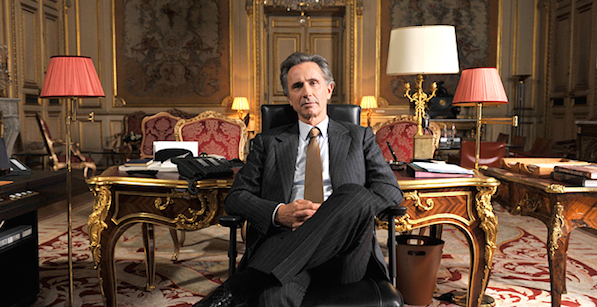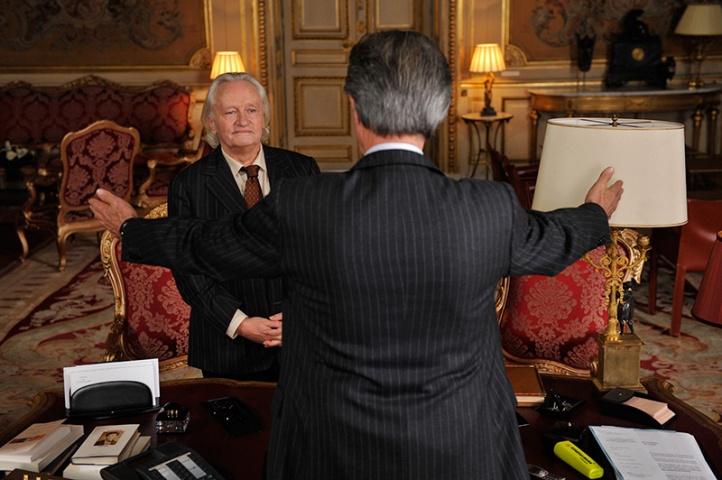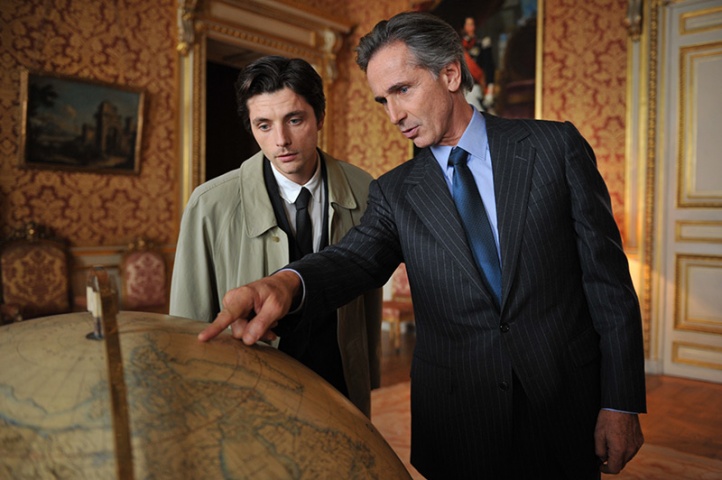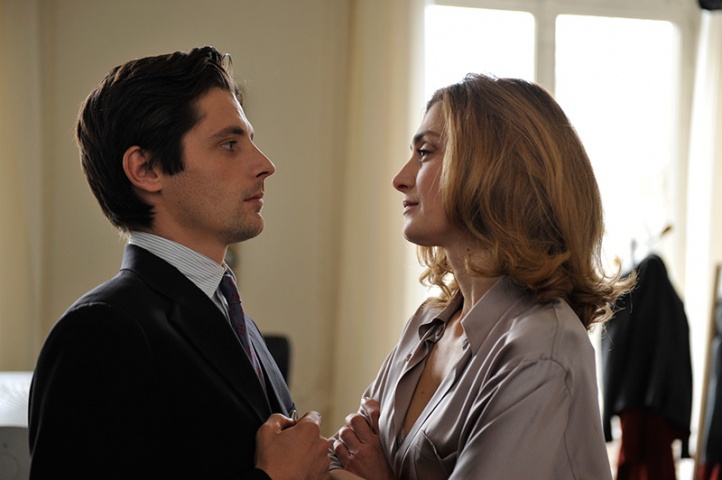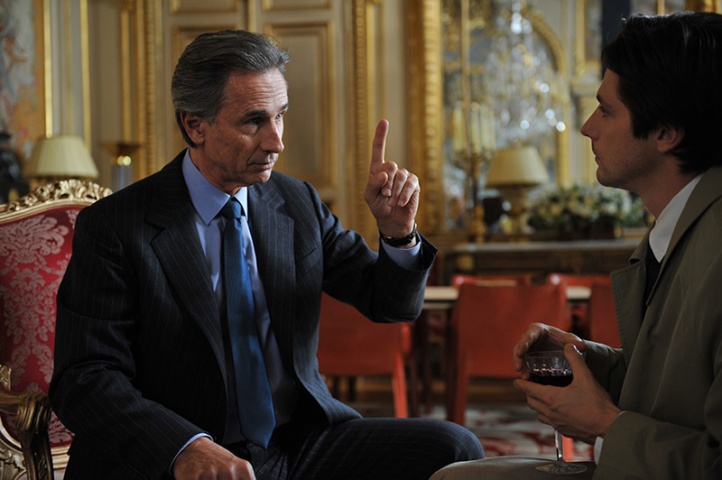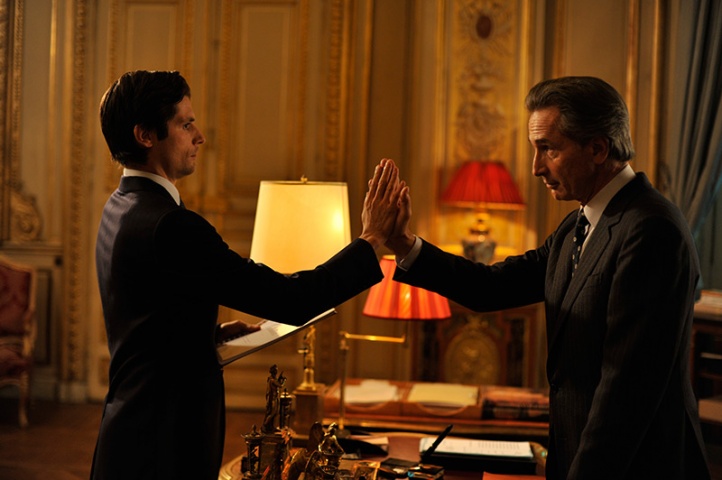A great filmmaker can make something interesting out of just about anything. Bertrand Tavernier is just such a filmmaker, a cineaste responsible for arguably the greatest adaption of a Jim Thompson novel (Coup de torchon), one of the finest jazz-themed stories ever committed to celluloid (’Round Midnight) and a French procedural (L.627) that essentially reinvents the whole genre over its two-hour-plus running time. For his latest, Quai d’Orsay [The French Minister], Tavernier begins with the deceptively simple foundations of a graphic novel steeped in political intrigue and makes something entirely unique (and hilarious) in the process. Fandor co-founder Jonathan Marlow has spoken with Bertrand Tavernier several times over the past decade (often at the Telluride Film Festival) and even filmed an interview between Tavernier and Eddie Muller for the Film Noir Foundation’s release of The Prowler. The following conversation occurred at the Toronto International Film Festival (as arranged by Ryan Werner).
[In retrospect, the following conversation is fairly specific to Tavernier’s latest film and, if you haven’t seen it, the discussion might be a little too “inside baseball” for your liking. Then again, it should encourage you to see it.]
Jonathan Marlow: What were the origins of the production of Quai d’Orsay [The French Minister]?
Bertrand Tavernier: It was initially a graphic novel. A friend of mine brought me the first volume. The second [in the series] had not been published. It was about five or six days after the publication and I immediately called my partner. I said, ‘Let’s buy the rights. I want to do this as a film.’ I thought it was very, very funny. I met the two people responsible: the writer [Antonin Baudry, a.k.a. Abel Lanzac] and the cartoonist [Christophe Blain]. The writer told me quickly that it was his story.
Marlow: His own story?
Tavernier: He’s a young man. This is his life (and he is still working at the Quai d’Orsay).
Marlow: How did the people with whom he worked take this particular interpretation of the workplace?
Tavernier: He worked during three, four, five years with the model of Alexander Taillard de Worms. He knew it, really.
Marlow: Inside and out.
Tavernier: I wanted them as co‑screenwriters. Even the guy who illustrated. We wrote the first draft, I think, in ten days. I remember at least three or four times we would look at our watch and it was 4:00 a.m. We had not had any dinner. We had not stopped from the morning; just for a quick lunch. We had a first draft in eight or nine days, in a state of exhilaration. We were laughing constantly, changing things in the graphic novel. I came with very precise ideas. Change the character of the girlfriend of the hero, for instance, and give her a job.
Marlow: Make her a teacher?
Tavernier: Make her a teacher. Give her a job. We had to do this with her with six or seven scenes, where she is making fun of the people in the cabinet and where you see that they are together, imitating them. That creates something which is beyond that they love each other. It’s a way of surviving by having all of those…
Marlow: It is a way of establishing a certain sanity in the situation.
Tavernier: Exactly. When we were working, I was always questioning Antonin about certain things. Out of some moment of his life we had those scenes. Two months before the shoot I’d reread the script and said, ‘My God, there is one thing missing. We never see how the last (and the most important) speech was written.’ I called Antonin and he said that it was written in a totally different way than all of the others. Everybody was in the same room. I immediately wrote a draft. He rewrote it and sent it back. He added the phrase that became very important. ‘The old country’ was absolutely imposed by the minister. That was his idea.
Marlow: That adds continuity to the previous speech that was given in New York.
Tavernier: But everybody around him was against it. After I made the film, I met some people who said even when they were going from the airport to the hotel in New York, President Jacques Chirac called and said, ‘Take off that expression ‘the old country.’ He resisted and he was right. That marked the mind of everybody at that time. Speaking from an old country, an old continent. This was the first and maybe the only time that a speech at the U.N. was applauded.
Marlow: It is a very dramatic moment. How the audience will react isn’t quite in the build-up. The enthusiasm for the speech has a very natural progression.
Tavernier: At the first screening in France, the reaction was enormous to the speech at the end and how we are slowly driving to that. It was very important to add this scene where they are writing it. Even if it is a scene of comedy, then we have a scene after which is not comedy where you discover that the minister had the people with new papers, the parents. . . .
Marlow: It is handled in a very beautiful way. It is introduced almost as an aside. You don’t know that this is going to happen, the minute he slips the paper into his pocket. Nothing more is said of it until his efforts are revealed. We really see things through his perspective. He didn’t know anything about it either.
Tavernier: Yes, he didn’t know! When I shot the scene with Jane Birkin. . . .
Marlow: . . .which is very inspired casting!
Tavernier: Jane told me that she went to the model of Dominique de Villepin with the same thing. Twice she went with some families who needed papers and immediately he took care of it. I had added a scene in the script that had happened in real life. Suddenly we invent something in fiction and we proved that our writing was in tune with the reality, even if it looks surprising.
Marlow: How much of the mise‑en‑scene actually comes from the graphic novel?
Tavernier: Very little. Once or twice, I looked at something. When you want to get the impression of the majesty of the office of the minister, the best way is to be near the back and to see very little of his office. The chair, the three windows (which are legendary) and that oval office. That I had to take. The same way the room where they have all the cabinet meetings, they’re all centered on the fact that you have that window which is a half-circle. That I had to do the same as him because that gives exactly the geography of the room; it gives the room specificity. For the rest, I tried to find ideas. I didn’t want to copy because it is two totally different ways to tell the story. In his drawing, when the minister becomes animated, his arm multiplies. He has several arms. You can do that with CGI but, for me, it didn’t seem very interesting. Instead of that, I proposed immediately the idea that when he comes into the room, all of the papers are flying.
Marlow: It’s a great motif. The constant slamming of the doors when people know he’s coming. . . .
Tavernier: Yes, exactly. Always the papers are flying and he never looks at that. That becomes the description of the character, somebody who is so obsessive that he never looks at the damage he is doing. It falls on the secretary to pick up the files and the papers.
Marlow: What strikes me as interesting is the way in which you deal with the intersection of fantasy and reality, the relationship between France and the U.S. It manifests itself in very interesting ways. Definitely the film ends with the speech in New York. But references to ‘The Bridges of Madison County,’ this idea of an idyllic representation of American culture in some respects and in the way that these things get interjected. It’s very sardonic.
Tavernier: I added the reference to ‘The Bridges of Madison County.’ That was not in the graphic novel. When he says, ‘America is a different place, different environment.’ For instance, take Iowa. Every time someone said the word ‘Iowa’ we had a ‘ding.’ I wrote the thing where he says Iowa is where ‘The Bridges of Madison County’ was shot. [Laughs.] It’s a gesture. It’s a figure-eight. It has no place in this picture about the UN. It’s totally mad. ‘I love Americans more than they love themselves.’ Thirty percent of these people are eating in their cars.
Marlow: These absurd witticisms. He just throws these things out. How early in the process was it decided to break the narrative up with the fragments? It’s a great . . .
Tavernier: Right from the beginning. It was in the graphic novel. I think one of the first things he said was, ‘Are we going to keep that?’ I said, ‘Yes, I think it’s wonderful to have in the film a lot of quotations from Heraclitus.’ A lot of them are very difficult to understand. It’s becomes funnier and funnier.
Marlow: It’s almost more absurd as it goes along. Initially you’re trying to make these references as chapter points. Then, as it goes along, you recognize that there is no relationship. You’re searching in the way that the characters are stretching to use these words.
Tavernier: The only one when they say ‘sorcerers’ and then you cut to Africa. There is sometimes something [that connects them] but most of the time it was making fun of the people who make chapters in a film and try to tell you what is going to happen. From the quotation, you cannot guess what is going to happen. [Laughs.]
Marlow: It seems that you have a very particular soft spot for this character. Even in his absurdity, he still is able to accomplish things.
Tavernier: In spite of his behavior, in spite of his craziness, in spite of the fact that (half of the time) even I cannot understand what he is saying. I don’t know what it must have been like for the people who were forced to write for him when they are given things like ‘la foudre.’ They have some instruction. When he says in the speech, ‘no nerve, the opposite of the modern stew,’ to try to understand what he means, it’s just . . . I could see very well how people could suffer with such orders. At the same time, even in his pathos, even in that, he had a few elements where he’s right. There were not many in the French government. Right from the beginning he knew that was a total stupidity. He was opposed. He said, ‘War will have a devastating effect.’ He had that kind of lucidity. The positions France took were very respectable. Many, many, many mistakes, enormous mistakes, would have been avoided if he had been followed. He had that. Once or twice when he says, ‘Europe should be a symbol,’ it’s said in a very pompous way. But, in a way, he’s right. Europe now is just people who are talking endlessly about cheese.
Marlow: Yes. Or the missing bear.
Tavernier: Never about any subject defense, the economy or the tax system. I mean, in Europe nobody, especially not Mr. Barroso, is doing anything about the fact that those trusts and companies are not paying taxes anywhere in Europe. I mean, Google, Yahoo, Starbucks, Amazon, they’re avoiding tax everywhere. Europe never speaks about that, never reacts. They are not even trying to. The [French] government is. The German Parliament is. The British Parliament is. But Europe… He’s right on that. He has that. Yes, I have to find him. [Laughs.] In a way, I like him in spite of . . .
Marlow: . . . of his insanity?
Tavernier: Of his total insanity.
Marlow: I would say that it is clearly crucial to get that balance correct. It would be difficult to imagine a better cast for this film.
Tavernier: If I can look arrogant and full of vanity, I was always very good at casting. In practically all of my films, I never work with casting directors. I do the casting myself. In the case of Quai d’Orsay, coming back to the way we were working in France, the casting was done by the director and the first A.D. It’s how a lot of assistant directors become directors. During the years they work with directors they were helping on the casting. They knew the actors. It’s how Claude Sautet was doing that. Michelle Deville was the assistant director for Henri Decoin. He was casting and Decoin said, ‘Bring me all the new actors that you spot.’ He had that mission. Jacques Deray was doing it and I think that was great to have an assistant director who knows actor and who loves actor. I had done that in my first film, and I did that on that film with my first lady, who was a woman. We did the casting ourselves. And there were some actors I wanted to work with. Niels Arestrup was used to doing something different. I wanted to give him a part that was the opposite of what he has been doing. He said, ‘Tavernier, this is a terrifying challenge, because you are asking me to do the opposite of what everybody’s asking me in the last thirty years. It’s the opposite of my nature. My nature is to be extroverted.’ In most films, Niels Arestrup is yelling, screaming and fighting.
Marlow: His restrained performance is one of the best things I’ve ever seen him do. It is exceptionally ‘against type’ from what you’re used to seeing. His unusual inner calmness and his acceptance of the absurdity of the situation. He’s just not fazed by any of it at all.
Tavernier: He solves everything. You can see that he’s the one…
Marlow: He’s the orchestrator, basically.
Tavernier: Yes. He does the whole work. He does all of the work and he’s a legend in the institution. Even the people now… when we shot, we were talking with the guards and they were saying, ‘He was always working until four in the morning.’
Marlow: [Laughs.] There’s a moment where they call him from New York. They were arguing about what time it is and they call him. Immediately, he’s there just describing the whole situation. It’s early in the morning. This happened. He’s a consummate professional.
Tavernier: [Laughs.] Yes! And the gendarme said, ‘Sometimes we’re afraid that he had died because there was no noise.’ Sometimes he was dosing for half-an-hour and then working. At 3:30 a.m. or 4:00 a.m. he was going out, taking his private car. He never spent one franc of public money in changing his office, changing the furniture.
Marlow: Right. Yes. The cat is left by his predecessor. Everything is the same.
Tavernier: [Laughs.] Yes! Even the sneakers. He kept them.
Marlow: Exactly. They were even in the same place. I did have one other thing I wanted to understand. When you we writing the script, there is an intersection with the actual history of things as they happened. When the U.N. speech happens, you see a bit of George W. Bush giving a speech but the conflict itself is fabricated. To what extent is it essential to create a situation that is outside of reality in order to distance the audience from it being an authentic representation of reality?
Tavernier: It is outside of reality and, at the same time, it’s inside reality. . . .
Marlow: Right. It’s still touching on things that actually happened.
Tavernier: It’s always touching on something. The discussion about the weapon of mass destruction was exactly what was happening in France at that time. The problem is we never put real names on many people. The only one is [George W.] Bush and I had a lot of hesitation about that. Do I have to show him? I mentioned the neoconservative. But I never said ‘Cheney’ or ‘Rumsfeld,’ but I said ‘the neoconservative.’ Everybody understands who they are. That’s easy. When you see something on television, that dates the period.
Marlow: Correct. It makes it concrete.
Tavernier: It makes it concrete. I said, ‘Okay, I will do it if it is in the background of the image.’ It’s in the background. I will never make a close‑up. I will try to make it totally natural. It’s like the television is in the room and there is nobody really looking or even listening to it. It’s there. It’s there and it’s only the minister who says, ‘That asshole.’ [Laughter.] I think it helped. I think it helped but it’s very light. It’s too short. Too short in the background but the rest… everything is true. The idea that suddenly the Americans changed their mind and decide to go through U.N., that is totally true. The failure of the French speech was true. When [John] Kerry said, ‘This is Frankenstein speaking to Snow White and the Seven Dwarfs,’ that was totally true. At the same time, what was invented was Tin‑Tin. The one episode where we suddenly . . . I still cannot quite figure what he’s trying to say. [Laughs.]
Marlow: The point he’s trying to make there? Tin‑Tin is about these big challenges.
Tavernier: Yes, big challenges. Except at the end he says, ‘I want to sit at the table and talk with the guy instead of having it explode.’ [Laughs.] That is something I think we changed one day before shooting. I said, ‘I need a stronger line of reaction after that moment where he seems completely exhausted.’ He says, ‘How do you get out of the roller coaster?’ Because that relayed the impression that…
Marlow: …it was just going around and around.
Tavernier: Yes! That was the kind of thing where the line was written the night before. The story of the bear is totally true.
Marlow: It is? I wondered about that. How does it resonate? I can say honestly at the screening that I went to I haven’t heard an audience laugh that hard in a film in ages. In the U.S., there isn’t a lot of crossover. We’re generally quite ethnocentric. We don’t talk about what is happening elsewhere enough. It wasn’t clear to me to what extent some of those things, the issue of the missing bear, and how they were focused on…
Tavernier: But just the effect (even if you don’t know) is very funny. That the President is obsessed by the bear, which . . .
Marlow: But presumably it resonates deeper when the film opened in France. There are different reactions between different audiences.
Tavernier: I know that, but I received an email from a very good American critic called Gary Giddins. He’s a jazz specialist who wrote a splendid biography of Bing Crosby. He said that he had laughed from the beginning to the end. He knew nothing about the film. He’d never heard of it. He said it has the same frantic pace as Billy Wilder, One, Two, Three. [Laughs.] He said that it’s smarter and it’s more stylish in the shooting, the photography. He said, ‘My wife and myself, we’re still quoting the lines about entropies.’ About when she brought the New York Times, she says, ‘It’s wrinkled.’ [Laughs.]
Marlow: How long was the shoot? There was at least a day in Berlin, of course.
Tavernier: A day in Berlin, a day in Senegal, three days in New York, too. Because the most complicated challenge for the young DP I had (the very, very good Jérôme Alméras) was I wanted long tracking shots in the hotel suite where you have mirrors and windows everywhere. How do you light it? Typical of the American organization was the bus accident, where the car was going in front of the bus. I had a very, very good American team with a wonderful producer [Isabelle Kostic Crosley]. We did about five or six meetings with the guy in charge of the stunt who was bringing small cars and asking me what I wanted. The morning of the shoot we do the same thing on the pavement, redrawing everything, and then the moment after we discovered that he didn’t have the permit to drive the bus! [Laughs.]
Marlow: Oh, no.
Tavernier: We spent about five hours in multiple discussions. Then the guy who was going to drive the bus had never done any kind of work in film and could not understand what he had to do. That is a strange way, sometimes. The Americans who are working here are spending an enormous time on certain details and yet they are forgetting…
Marlow: …the important ones.
Tavernier: The important ones! The guy had a permit to drive a bus but not a bus as big as this one. But we did it!

